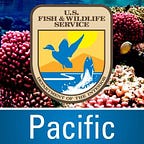Hundreds of Seabirds Assisted During Hawaiʻi’s Seabird Fallout Season
By Jordan Akiyama, Public Affairs Specialist, U.S. Fish and Wildlife Service
Hawaiʻi’s seabird fallout season, which takes place roughly between September 15 and December 15 each year, has ended. Every fall, young seabirds leave their nest to take their first flight towards the ocean and can become disoriented by artificial light, collide with man-made structures, or become exhausted and “fallout,” where they remain vulnerable to automobiles and predators.
“The Division of Forestry and Wildlife and our native seabirds have for years depended on the compassion of people who want to see grounded seabirds rescued and safely returned to the sea,” said David Smith, administrator with the DLNR Division of Forestry and Wildlife. “These are sea-going birds that navigate by the stars and are most at home when gliding over the surface of the ocean, much like the early human inhabitants of the Pacific. These birds have been doing this for millennia, but now they need our help navigating modern urban landscapes.”
While there are more than 20 species of seabirds that nest in Hawai‘i, the concern during fallout season pertains to seabirds protected under state and federal law: ‘a‘o (Newell’s shearwater), ‘ua‘u (Hawaiian petrel), ʻakēʻakē (band-rumped storm petrels), and ‘ua‘u kani (wedge-tailed shearwater).
The U.S. Fish and Wildlife Service works closely with the State of Hawaiʻi DLNR DOFAW and licensed wildlife rehabilitation organizations like Save Our Shearwaters and the Hawai‘i Wildlife Center to protect seabirds that need help during fallout season.
This year’s fallout season saw:
- 76 seabirds admitted and 63 released from DLNR DOFAW, Maui Nui Seabird Recovery Project.
- 572 seabirds admitted and 481 released from DLNR DOFAW on Oʻahu and Hawai‘i Wildlife Center (Hawaiʻi Island, Maui Nui and O‘ahu). Of these seabirds, 565 were admitted and 475 were released from O‘ahu Seabird Aid Program (Hawaiʻi Wildlife Center, Feather and Fur Animal Hospital, DOFAW).
- 168 seabirds were admitted and 139 released from Save Our Shearwaters on Kaua‘i.
“Thank you to the support of our partners and community members who have made this year’s seabird fallout rescue and rehabilitation efforts successful,” said Earl Campbell, Pacific Island Fish and Wildlife Office field supervisor. “While the fledgling season of the ‘a‘o, ‘ua‘u, ʻakēʻakē, and ‘ua‘u kani has reached the end, these seabirds can still use our help year-round. Artificial lighting, power lines, and other man-made structures will continue to be obstacles for adult and young seabirds during the breeding, nesting, and fledgling seasons, which go from March 1 to December 15. Although adults can be disoriented by nighttime lighting, fledglings are the most susceptible. So we ask for your help preparing for the next seabird fledgling season. You can install wildlife-friendly lighting in advance of the fledgling season, and/or remove unnecessary lights. Minimizing light pollution is not only beneficial for wildlife but also human health, and preserves the night sky.”
“We work with a number of partners, which makes seabird fallout recovery and release possible,” said Sheri S. Mann, Kaua‘i DOFAW branch manager. “It is very important to maintain and grow this collaboration so seabirds that are hurt or harmed have a second chance at life. This important recovery work coupled with extensive protection and conservation efforts need to continue if these important birds are to persist on our islands.”
Unlike the ‘a‘o, ‘ua‘u, ʻakēʻakē, the ‘ua‘u kani nests in vegetation along coastlines. Nesting adults, eggs, and chicks are particularly susceptible to impacts from human disturbance and predators. Ground disturbance such as construction, coastal vegetation or sand disturbance could destroy and bury ‘ua‘u kani in their habitats. Also, if you live near coastal areas or visit beaches, please remember to keep pet cats indoors, leash dogs when going for walks, and inform other members of the public to help conserve protected native species.
For more information on how to handle a downed seabird, visit our Conservation in the Pacific Islands page. Members of the public who have questions regarding seabird fallout or where to drop a downed seabird of can visit https://dlnr.hawaii.gov/wildlife/downed-wildlife-contact-details/
The U.S. Fish and Wildlife Service works with others to conserve, protect, and enhance fish, wildlife, plants, and their habitats for the continuing benefit of the American people. For more information, visit www.fws.gov/pacificislands, or connect with us through any of these social media channels at https://www.facebook.com/PacificIslandsFWS, www.flickr.com/photos/usfwspacific/, www.tumblr.com/blog/usfwspacific or www.twitter.com/USFWSPacific.
